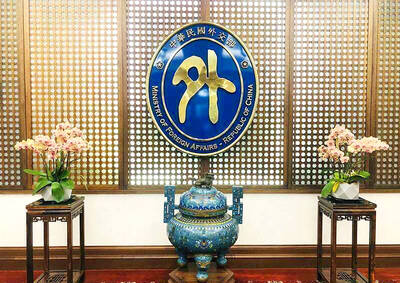A US decision not to sell Taiwan new F-16C/D fighter jets is being seen by many US allies in Asia as a sign of China’s growing clout.
The pre-eminent military power in East Asia for 50 years, the US has explicitly and implicitly provided a security umbrella for countries from Singapore to Japan, helping to keep the peace that has fostered stunning economic growth.
While few of these allies believe the US is lessening its commitment to the region, they still see Washington’s refusal to make the F-16C/D aircraft sale, which was made public on Wednesday, as showing a new deference to Chinese interests.
China is a “big factor ... that can’t be discounted,” Philippine Defense Secretary Voltaire Gazmin said. “All things are always considered in a decision and China is a world player now.”
The top US diplomat for East Asia, Kurt Campbell, publicly confirmed in New York on Wednesday that the administration of US President Barack Obama will upgrade Taiwan’s existing fleet of F-16A/Bs, postponing for now the sale of the new models that Taipei sought.
The decision brought a swift, angry denunciation from Beijing, where Vice Foreign Minister Zhang Zhijun (張志軍) summoned US Ambassador Gary Locke to warn that exchanges between the militaries, security cooperation and overall ties will suffer.
After reducing its footprint in East Asia during the administration of former US president George W. Bush, the US began pushing back last year. US Secretary of State Hillary Rodham Clinton offered strong support to Asian allies in response to their unease about a more assertive Chinese naval posture in the South China Sea, and the US military conducted high-profile drills with Japan and South Korea.
However, doubts about US staying power in the region persist, and Washington’s refusal to sell the new F-16C/Ds to Taiwan could serve to deepen them.
Admittedly, Taiwan is not a typical case when it comes to security assistance from the US and most other countries, but Taiwan’s defense ties with the US still run deep.
Taiwan hosted US troops for decades under the terms of a security pact that lapsed only after the US shifted its recognition from Taipei to Beijing in 1979. And since then, Washington has remained bound by a Congressional mandate to sell Taiwan weapons to help defend itself against the attack that China threatens if Taipei moves to make its de facto independence permanent.
The complexity of this relationship helps explain the intense Washington reaction that was engendered by the Obama -administration’s decision on the fighter planes, which denied Taiwan the 66 new F-16C/Ds it long coveted, while permitting it a series of upgrades on its existing fleet of F-16A/Bs.
Supporters of the decision regarded it as a Solomonic compromise, taking account of Taiwan’s defense needs — particularly its growing air power gap with China — while also safeguarding the integrity of the US’ increasingly important relationship with Beijing.
However, critics blasted the decision as a sellout of a democratic bastion and long-standing security partner, and a move that could even rattle Asian partners’ confidence in US commitments.
Even before news of the decision became final, Republican Senator John Cornyn of Texas, where the Lockheed Martin plant that would have built the new F-16C/Ds is located, described it as a slap in the face to a strong ally, and Howard Berman, the ranking Democrat on the House of Representatives Foreign Affairs Committee, called it a “half-measure.”
In Asia, it is seen as yet another example of China’s growing military and economic power.
Gazmin saw the move primarily as the result of Washington’s limited options in the face of China’s significant holdings of US Treasuries, and the threat that poses to US fiscal stability.
“It has a large debt and if China will try to apply pressure, the US can end up in trouble,” he said. “The US has to temper its relations with Taiwan for China.”
However, Gazmin rejected the notion that Washington’s decision could point to an eventual unwinding of its long-standing security ties with the Philippines, which include close cooperation in fighting Muslim insurgents in the southern part of the country.
“We have a separate, special relationship with the US that’s different from its relations with Taiwan,” he said. “The US ties with Taiwan [are] different from ours and other countries, the dynamics are different.”
China expert Lee Chang-hyung, of Seoul’s government-affiliated Korea Institute for Defense Analyses, also saw the US decision to deny Taiwan new F-16C/Ds as reflecting China’s economic leverage in Washington.
“If it sells the fighter jets to Taiwan, it could sustain some big economic damage,” he said. “I think the United States has taken that factor into account.”
Lee said China’s meteoric rise — underlined by its rapidly expanding military and its lightning economic growth — has prompted some South Koreans to conclude that Seoul’s best interests lie in downgrading its decades-old security alliance with the US in favor of closer ties with Beijing.
However, he rejected that approach, in part because he believes China is still dozens of years away from catching up with the US militarily.
“We have to maintain and bolster the alliance with the United States — which is far away from us — while expanding and improving exchanges with China — which is close to us,” he said.

Temperatures in northern Taiwan are forecast to reach as high as 30°C today, as an ongoing northeasterly seasonal wind system weakens, the Central Weather Administration (CWA) said. CWA forecaster Tseng Chao-cheng (曾昭誠) said yesterday that with the seasonal wind system weakening, warmer easterly winds would boost the temperature today. Daytime temperatures in northern Taiwan and Yilan County are expected to range from 28°C to 30°C today, up about 3°C from yesterday, Tseng said. According to the CWA, temperature highs in central and southern Taiwan could stay stable. However, the weather is expected to turn cooler starting tonight as the northeasterly wind system strengthens again

The Ministry of Foreign Affairs (MOFA) yesterday expressed “grave concerns” after Singaporean Prime Minister Lawrence Wong (黃循財) reiterated the city-state’s opposition to “Taiwanese independence” during a meeting with Chinese Premier Li Qiang (李強). In Singapore on Saturday, Wong and Li discussed cross-strait developments, the Singaporean Ministry of Foreign Affairs said in a statement. “Prime Minister Wong reiterated that Singapore has a clear and consistent ‘one China’ policy and is opposed to Taiwan independence,” it said. MOFA responded that it is an objective fact and a common understanding shared by many that the Republic of China (ROC) is an independent, sovereign nation, with world-leading

COOLING OFF: Temperatures are expected to fall to lows of about 20°C on Sunday and possibly 18°C to 19°C next week, following a wave of northeasterly winds on Friday The Central Weather Administration (CWA) on Sunday forecast more rain and cooler temperatures for northern Taiwan this week, with the mercury dropping to lows of 18°C, as another wave of northeasterly winds sweeps across the country. The current northeasterly winds would continue to affect Taiwan through today, with precipitation peaking today, bringing increased rainfall to windward areas, CWA forecaster Liu Pei-teng (劉沛滕) said. The weather system would weaken slightly tomorrow before another, stronger wave arrives on Friday, lasting into next week, Liu said. From yesterday to today, northern Taiwan can expect cool, wet weather, with lows of 22°C to 23°C in most areas,

Taiwan sweltered through its hottest October on record, the Central Weather Administration (CWA) said yesterday, the latest in a string of global temperature records. The main island endured its highest average temperature since 1950, CWA forecaster Liu Pei-teng said. Temperatures the world over have soared in recent years as human-induced climate change contributes to ever more erratic weather patterns. Taiwan’s average temperature was 27.381°C as of Thursday, Liu said. Liu said the average could slip 0.1°C by the end of yesterday, but it would still be higher than the previous record of 27.009°C in 2016. "The temperature only started lowering around Oct. 18 or 19